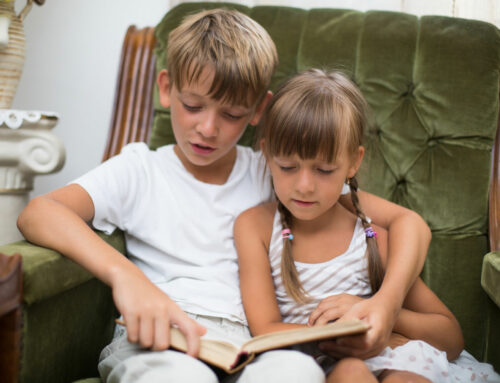By Sarah Lyons
We all deal with feelings of anger and frustration at times. While these feelings are normal, it is important to help our children appropriately respond to these feelings.
Perhaps you never thought about working together on this issue. After all, you’re the parent and they’re the children! But, parents and kids can work as a team to come up with strategies for these situations.
Preparing a plan together will help children learn how to calm down and discuss why the feelings occurred. Consider this advice from Parents.com:
“Unfortunately, many kids have never been given the opportunity to think of those other ways to calm down. They keep getting into trouble because the only behaviors they know are inappropriate ways to express their anger…Once the child chooses his ‘calm down’ technique, encourage him to use the same strategy each time he starts to get angry.”
Also consider these examples of how to help your children with anger at the four major stages of childhood.
1. Anger Stage: The Toddler Years (ages 0-2)
Prepare: Observe what calms your child. Is it snuggling up with a parent? What toys does she play with quietly? Make note of what is calming for your child and use these activities later when the child is upset.
Act: Children of this age do not understand their feelings. When your child becomes frustrated and angry, use a calming technique that you observed. You should also remain calm yourself and use a soothing voice while speaking to your child. Ideas for how to act include
- Sing a song
- Snuggle up with a book
- Get out a new toy
- Start a new activity
Discuss: Think about what caused the child’s anger and discuss with other caregivers what may be common frustrations for your child. Just like with Mommy and Daddy, irritability is often an indication the child is tired or hungry. Establishing meal and bedtime routines can help prevent meltdowns. Caring for yourself in the same way will help you to more calmly handle the tough times.
Keep in mind that toddlers have few strategies for communicating their feelings. Crying and tantrums are normal until they learn alternatives. Be patient and know that this stage will pass as your child matures and her vocabulary develops.
2. Anger Stage: The Preschool Years (ages 3-5)
Prepare: On a calm day, talk with your preschooler about different types of feelings, giving names to them. Books, charts or photos are also helpful. Then, discuss appropriate behavior when angry and talk about actions to help calm down. Calming suggestions for preschoolers may include:
- Drawing a picture
- Playing with cars
- Doing a simple puzzle
- Singing and dancing to music
- Running and jumping
- Hugs!
“With my five year old, slow deep breaths help. Then, when he can talk, we discuss what has upset him,” suggests Sherrie Hoffman of Hiawatha, Kansas.
Act: When feelings of anger begin, ask in a calm voice what is causing the issue, then try one of the techniques discussed earlier. Remind your child that you will talk about it when he is calm. Do not feed into his actions unless he is working on becoming calm.
Discuss: Later, ask your child to share why he became angry and come up with ideas to prevent the situation in the future. Remind him it is normal to feel angry at times and when he uses a calm-down strategy, praise him for it.
3. Anger Stage: The School Years (ages 6-11)
Prepare: Discuss common triggers for your child and come up with a plan of how to handle these triggers. Talk about the difference between appropriate and inappropriate anger.
Like the preschool age, come up with a technique that helps calm your child and plan to use it when needed. Ideas for this age group include:
- Going to their bedroom and listening to their favorite music
- Kicking a soccer ball or playing catch
- Swinging on the swingset
- Screaming into a pillow
Act: When your child becomes angry, calmly let her know that you see she is upset and would like to talk about it when she is calm.
“We don’t talk about a problem until they are calm and if they get worked up while explaining what is wrong, then we take deep breaths until they are calm again.” says Rachael Kennedy, mother of five.
Discuss: When your child has calmed down, listen to her frustrations. Let her know it is okay to feel angry and praise her for handling it well. Ask her what could have been different and come up with solutions as a team.
4. Anger Stage: The Teen Years (ages 12 years and up)
Prepare: At this age, your child should be aware of what sets him off. You, as the parent, probably already know, too! Try to problem solve how to avoid situations that make him angry, but don’t let his anger intimidate you into inconsistent discipline. Tension in the teen years is a given, so it is best to strategize ways to cool-down when he is calm. Ideas for how to help your children with anger at this age include:
- Taking a walk
- Tidying up their room
- Listening to music
- Journaling
- Taking a shower or bath
- Calling a friend to vent
Act: Calmly mention that you see he is angry and ask him to please take a break from the situation until he can calm down. Give him space unless he wants to talk and be patient. If appropriate, leave him alone in house to calm down.
Discuss: Later, when everyone is ready, discuss what happened. Problem solve what a solution could be now or in the future. Come to a compromise about what could be different and ask him for as much input as possible.
The goal of these techniques is to teach your children that feelings like anger are normal; what is important is how to deal with these feelings. Teaching these techniques gives kids the tools they need to deal with anger in an appropriate way. It also teaches them how to problem solve to work through a frustrating situation. Yes, you can work as a team to be more successful dealing with anger!
Tips to Help Parents Cool Down
It is no secret that our behavior as parents affects our kids. How a parent deals with feelings of anger can have a huge impact on how our children will react when they feel angry. Here are some tips to model appropriate behavior when those feelings occur:
- Walk away.
- Take deep breaths.
- Keep a calm voice.
- Use calm body language (no slamming doors or stomping around).
- Diffuse anger by doing a calming activity (tidy up, take a walk, splash water on your face, etc.).
- Fake it until you make it.
- Make a commitment in advance to keep your cool.
- Think about how your actions affect your kids.
- Acknowledge that it is normal for children to push your buttons.
- Try to see the humor in the situation.
***
Sarah Lyons is a wife and mother of six children living in suburban Kansas City.



